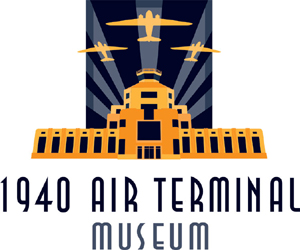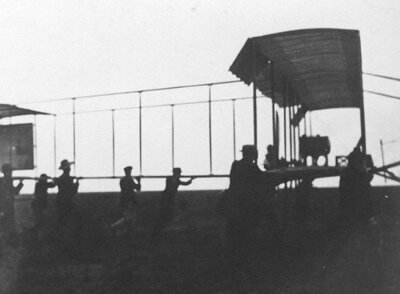First Flight in Texas
Friday, February 18th, 1910 was supposed to be a better day. The day before had provided the typical windy, cool conditions of mid-winter along the upper Gulf Coast. After assembling his fleet of airplanes and preparing them to make their attention getting circles around the muddy field, air show "King" Louis Paulhan had waited just a bit too long.
By late afternoon the winds were too high to fly the delicate Farman biplane or the difficult to control Bleriot monoplanes. The crowd that had assembled was unhappy. They had each paid $1 to see one of the new "aeroplanes" fly. Many had taken the day off from work, or skipped school! The show promoters, the Houston Post and The Western Land Company, wanted to draw a crowd down to South Houston to show off their housing development. What better way than with a demonstration of the "new fangled" flying machines!
Paulhan had been making a long, slow trek across the United States on his way back to New York. After a rousing success at the Los Angeles Air Show and Race in January, he was riding the rails to a variety of stops before reaching the grim, overcast and windy Texas coast.
His crew of two, along with he and his wife, arrived by rail on Tuesday. By Wednesday their airplanes had been partially assembled and trucked, by horse no less, to a field at the corner of Spencer and Galveston Highways. Sodden, the field would have to do, as he had to fly to secure his "sponsorship" from the promoters.
Paulhan had just about had enough. Ever since arriving in the United States he had been dogged by attorneys from the Wright Brothers. They had a patent on the use of attitude adjusting "wings" on airplanes and were intent on stopping others from utilizing any similar device. Paulhan and Curtiss had both protested and denied the Wrights’ claim on their airplanes, but a court fight would be expensive and time consuming. Best to get this flight over, in this damp, gray windy place and get back to Europe where the Wrights couldn’t hound him.
On the morning of February 18, 1910, the sun rose through a high diaphanous overcast…the wind was low, but would certainly rise as the morning progressed. "Allez!", he shouted to his crew. "Let's go!"
The aircraft was embraced by a group of men, both his crew and several locals employed for the task, and they shouldered the large, fragile Farman biplane from its staging area onto the field. Paulhan assembled his flying gear, consisting of little more than goggles, his ever present hat and a set of gloves.
He had to be careful for the Farman biplane was delicate, being not much more than a large boxkite held together by wooden struts and wire. Would the wheels get stuck in the mud? What if there was a sudden gust? Would the engine run well? – would it even start?! With only 50 horsepower it was temperamental, prone to surges or simply not starting. With that in mind he helped fuel the tank, and prime the engine feed line. He climbed into the front seat of the Farman and tested his controls. All seemed free in their motion.
He signaled to his crew to spin the propeller. This was a dangerous job, with the pusher prop located between the bridgework that connected the tail. It would be easy for a crewman to leap out of the prop’s spin and into the wires and become entangled. He could damage the delicate wood and wire structure that held on the tail, or hurt himself in the spinning prop! Usually the crewman simply fell flat onto the ground, crawling away from the propeller by ducking under the structure. The others were already holding the wings to prevent a sudden departure of the craft.
As the crewmen restrained the shuddering, rocking and noisy Farman. Paulhan raised his hand and then suddenly dropped it. At that moment the crew released their grip and quickly moved away from the now accelerating craft. It pointed into the morning sun and slipped into the air, rising above the grass of the coastal plains. He was flying! The crowd roared its approval!
This, he thought to himself, was magic! To arise like this – into the air – to go amongst the birds, to see the field, the figures below him…this was his life. All the rest of it…the lawyers, the train trips, the promoters…bah! -all had to be endured just so he could return to the air! Here he was alone…no shouting…just the steady thrum of his engine as he enjoyed the expanding panorama. He could see a large bay in the distance with the morning light glinting off its expanse. Below he could see the railroad stretching toward the distant coast at one end, and the city of Houston off to the north.
He slowly began a wide turn to return to the crowd. He could see a number of individuals racing along, trying to follow his every move. He passed over the assembled crowd of visitors, sponsors, officials and curiosity seekers and noted that the wind was already getting to be more than he had reckoned on. Best to get the ship back on the ground.
He lined up with his crew and descended back to his starting point. He seemed to float over the crowd in the steady breeze, and after cutting his engine he gently dropped to the ground. The mud and tail skid stopped his delicate machine quickly, and just as quickly he was surrounded by his crew. "Vous l'avez fait!" they exclaimed. "Tre Bon!" Extracting himself he approached the dais to receive the adulation of the crowd and officials. The first airplane flight in Texas was over.
First Aviator in Texas (and France)
| 1909 | At age 26, received first French Pilot's License | |
| Dec. 1909 | Arrives in New York City sets altitude record | |
| Jan. 10-20, 1910 | Attends LA Air Meet and sets altitude record | |
| Jan. 29, 1910 | Attends Salt Lake City Exhibition and sets altitude record | |
| Feb. 2, 1910 | Attends Denver Exhibition and sets altitude record | |
| Feb. 13, 1910 | Attends New Orleans Exhibition | |
| Feb. 18, 1910 | Twenty-five thousand people attend and pay $1 to watch Paulhan fly a Farman biplane. | |
| March 15, 1910 | Leaves US | |
| April 10, 1910 | Wins London to Manchester Race | |
| 1963 | Dies in France |
First Texan Aviators
L.L. ("Shorty") Walker was in the crowd on February 18, 1910 when Louis Paulhan made the first airplane flight in Texas. Walker was determined to build his own airplane. He studied photos and plans for the French Bleriot monoplane and built his own craft in the shop of the Auto and Marine Company, one of Houston's first auto repair businesses. Walker purchased a 40 horsepower Kemp Gray Eagle motor for his craft. By August 1910, Walker's airplane was complete. He towed the craft to a field near Bellaire and proceeded to teach himself how to fly.
Walker was soon joined in the skies over Houston by Louis Foster Smith and Guy C. Hahn, who had also witnessed Paulhan's flight. Smith and Hahn spent over $13,000 building their craft. Smith & Hahn were so pleased with their design they established an airplane factory in South Houston and proceeded to build eight airplanes.
Walker proceeded to barnstorm around Texas and Missouri, making a living by charging admission to townspeople curious to see a man fly. With the onset of the First World War, Walker reported to San Antonio to teach military pilots to fly, first at Katherine Stinson's Stinson Field, and soon at the Army's Kelly Field. Walker was sent to the Curtiss Flying School at Newport, Virginia, then taught flying at Mineola, New York, Rantoul Illinois, Wichita Falls, Texas, Lake Charles, Louisiana and was teaching flying to the Corps of Cadets at Texas A & M College when the war ended.
Download this article in PDF format
The photographs used in this article and in the related exhibit are provided by The Sloane Collection / www.sloanegallery.com, the National Air & Space Museum and the University of Houston, courtesy of Special Collections, University of Houston Libraries. The map is used courtesy of J.R. Gonzalez, Houston Chronicle. Text by Michael Bludworth and Drew Coats.







